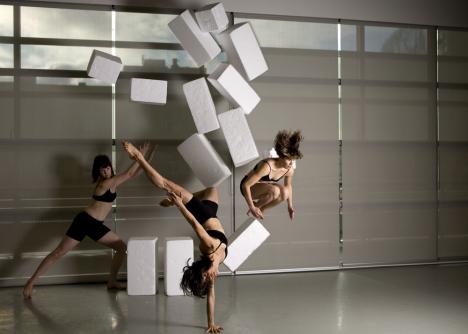Experiments: where logic and emotion collide

Collisions between dance and science or dance and technology seem de rigeur these days. In Vancouver, October 2010 saw the premiere of Co. ERASGA’s Shadow Machine, which professed to explore “the conflicting relationships humanity has held with machines and the industrial process since the first years of the industrial revolution.” VIDF 2010 gave us Kitt Johnson’s Rankefod, an “evolutionary solo performance in celebration of the origin of the species.” In the summer of 2010 the Plastic Orchid Factory offered the “contemporary dysfunction” of endDORPHIN, a work expressing an alienated, over-medicated 21st century neurosis through dance. Common to each of these works is an interest in bringing the (apparently) opposing poles of art and science together through a work of dance.
Link Dance Foundation enters the fray with Experiments: where logic and emotion collide, in which Artistic Director Gail Lotenberg “probes the parallels and contrasts” between dance and science. This ambitious theme is given shape by research that has preceded the work: it is the result of a three year process during which Lotenberg collaborated dancers and with four ecologists who specialize in “the study of non-verbal communication.”
The success of this performance lay in strong composition and strong choreography. Abstract ideas were translated into intuitive sensory information via projections, and the choreographer understood the phrase “less is more,” maintaining a reasonable balance between conceptual and sensual information. Brief voice-over and short interludes with dialogue were interspersed between works of dance that featured confident, emotionally vibrant choreography.
The opening scene set up a connection between scientific inquiry and dance. A lone figure wandered casually onto the stage, her motions loose-limbed and almost comical. Using a small flashlight, she traced patterns across the floor and walls, her body, and the audience itself. Her demeanor was relaxed and she made frequent eye contact with the audience. Combined, these elements suggested the kind of intellectual curiosity that crosses boundaries, an inquisitiveness that can be turned on minutia or on macrocosm.
This understated opener was followed by two types of performance: voice-over/in-person interludes by four collaborating ecologists, and lyrical dances that use the narrated material as jumping off points for performance. For example, scientist Lee Gass described his field research into hummingbird habitat in vivid language. Later he described the feeling of epiphany he experienced at finally understanding the import of data collected. His narrative offered the audience a rare glimpse into the daily life of a researcher, and hinted at the solitary, spiritual pleasure that is the reward for such intellectual work.
Picking up on the image of a data chart, the dancers entered with small cubes, which strewn across the floor created a glowing grid. Their motions between these squared off geometric points the charted their own path with gestures that were fluid and arabesque. Accessible as a metaphor for intellectual fulfillment, this imagery was still powerful, perhaps because the choreographer allowed the dancers simply to dance. The connection between the grid and the chart was clear but it was not belabored. Conceptual elements were apparent in the performance but they did not overshadow dance itself, which was given space to simply be what it was — physical, kinetic, wordless motion.
By far, the most impressive features of this show were the pure dance movements. Lotenberg’s choreography is satisfying at a deep level — there was strength, subtlety, and fearlessness in dancers movements. I found the duets between Cara Siu and Marvin Vergara particularly strong: they would compete, like fighters, faking and dodging around each other. Their bodies entwined and separated in ways that expressed both gentleness and strength. The choreography was complex – bodies moved simultaneously towards and around each other. There was a great deal of horizontal movement across the stage, a linear energy that added buoyancy to their lifts and falls. The total effect was enthralling.
In another “scene” a projected image showed marine conservationist Anne Salomon speaking with obvious wonder about her experiences observing marine ecosystems. As she described the patterns made by kelp under water, her image blurred, leaving traces across the screen. Dancers entered, and as they moved across the stage, their image traces were also projected, each motion over-writing the last and leaving trails for the eye to get lost in. The dancers made no claim to express profound scientific principles but made a connection between science and dance that was simple and aesthetic.
Experiments used voice-over and scientific observation as a kind of connective webbing between dance movements. The language of dance and the language of science were tightly meshed. The total work was an elaborate device constructed of these “organic” and “in-organic” materials (so to speak). The aesthetic pleasure of scientific pursuits was made apparent through narrative, and dancers were allowed to show the expressiveness of their art form.
There were a few weak moments: a scene about dance instruction seemed misplaced and awkward, though presumably the creator was making a point about instruction in both fields. I was also thankful that scenes were a scientist observed the dancers were short. Drawn out, these scenes would have been tedious, but used sparingly they helped to ground the abstractions of dance in a verbal and intellectual context.
Experiments: where logic and emotion collide does indeed read as an experimental work, in the sense that it tests boundaries and brings together contrasting themes in order to explore their relationship. Set next to other recent works that touch on scientific themes, its most unique characteristic are the devices used to frame the inquiry: actual scientific exploration interwoven with lyrical dance. Thanks to this close integration, the conceptual elements worked to support the performance elements.



